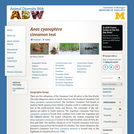
Anas cyanoptera: Information
- Subject:
- Life Science
- Zoology
- Material Type:
- Reading
- Provider:
- University of Michigan Museum of Zoology
- Provider Set:
- Animal Diversity Web
- Author:
- Maya Cadwell (author), University of Michigan
- Date Added:
- 03/07/2005

Anas cyanoptera: Information
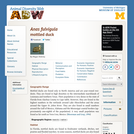
Anas fulvigula: Information

Anas laysanensis: Information
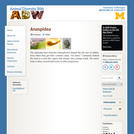
Anaspidea: Information

Anas platyrhynchos: Information
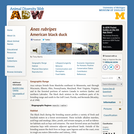
Anas rubripes: Information
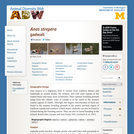
Anas strepera: Information

This resource is a video abstract of a research paper created by Research Square on behalf of its authors. It provides a synopsis that's easy to understand, and can be used to introduce the topics it covers to students, researchers, and the general public. The video's transcript is also provided in full, with a portion provided below for preview:
"Apoptosis is a form of cell death that occurs as part of normal development. Once considered irreversible, apoptosis might not mark the end for all cells—including cancer cells. Growing evidence suggests that cancer cells can be rescued from the brink of death through a process called anastasis, which could explain how tumors resist anticancer therapies. From the Greek for “resurrection,” anastasis can occur through a variety of mechanisms, such as by arresting the activity of caspases, enzymes in charge of dismantling the cell during apoptosis by activating DNA repair mechanisms and by allowing cell fragments to fuse and continue living even after apoptosis has begun. Further studies are needed to explore how cancer cells cheat death through anastasis and how to adjust anticancer therapies accordingly..."
The rest of the transcript, along with a link to the research itself, is available on the resource itself.
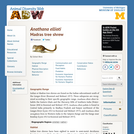
Anathana ellioti: Information
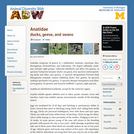
Anatidae: Information

Short Description:
This book is adapted from Anatomy and Physiology by Openstax. The text is designed to supplement an Anatomical Basis of Injury in Athletic Training course while providing review of basic Anatomy and Physiology.
Word Count: 124069
(Note: This resource's metadata has been created automatically by reformatting and/or combining the information that the author initially provided as part of a bulk import process.)

To further develop student learning of anatomical terminology, students will utilize the linked website ( Anatomical directional terms website link ) to use as a resource for defining each anatomical directional term. After taking notes over each term they will complete a project applying the terms in a video. This project can be used in courses related to health sciences when covering the topic of anatomically correct terminology related to directions when referencing the location of more than one location on the human body. Essential Questions:1. Identify body direction terminology.2. Recognize directional terms of anatomy.3. Use anatomical landmarks terms when referring to parts of the body.

This short video covers many anatomical terms.

Short Description:
This textbook is designed to actively engage your exploration and critical analysis of human anatomical variation in an Australian and New Zealand context. Understanding anatomical variation is essential for all health professionals to avoid patient misdiagnosis such as confusing a natural variant with a pathology, minimise surgical or procedural errors that may occur if variations are unexpected, and ultimately improve patient outcomes by applying culturally safe practices. Research in anatomical variation has demonstrated significant differences in phenotypic expression of variants between and within geographic, ancestral and socioeconomic populations, as well as displaying significant variance between males and females. It is therefore critical as a health professional to understand anatomical variation in the context of the population you intend to practice in. This textbook compiles this critical information into an easy to read summary of the range and frequency of anatomical phenotypes in Australian and New Zealand patients by drawing from contemporary anatomical science research. Anatomical variation of Aboriginal, Torres Strait Islander and Māori peoples has also been highlighted where research is available.
Long Description:
The anatomy of our outwardly facing physical appearance exhibits great diversity between individuals, from different eye, skin and hair colour to the size of our feet and our height. However, it is less known whether our anatomy differs beneath the surface… is the anatomy of the internal organs the same between individuals? Most textbooks would like you to think so with simplified standard descriptions of human anatomy such as the lung lobes and fissures, aortic arch branches and bone numbers. But this eBook is different. Here we build your understanding of the scope and clinical importance of human anatomical variation to improve your clinical skills as a health professional or biomedical scientist.
Anatomical variation is described as the differences in macroscopic morphology (shape and size), topography (location), developmental timing or frequency (number) of an anatomical structure between individuals. It presents during embryological or subadult development and results in no substantive observable interruption to physiological function. Every organ displays an array of anatomical phenotypes, and for these reasons the anatomy of each person is considered a variant. Understanding anatomical variation is essential for all health professionals to avoid patient misdiagnosis such as confusing a natural variant with a pathology, minimise surgical or procedural errors that may occur if variations are unexpected, and ultimately improve patient outcomes by applying culturally safe practices.
This textbook is designed to actively engage your exploration and critical analysis of human anatomical variation in an Australian and New Zealand context. Research in anatomical variation has demonstrated significant differences in phenotypic expression of variants between and within geographic, ancestral and socioeconomic populations, as well as displaying significant variance between males and females. It is therefore critical as a health professional to understand anatomical variation in the context of the population you intend to practice in. This textbook compiles this critical information into an easy to read summary of the range and frequency of anatomical phenotypes in Australian and New Zealand patients by drawing from contemporary anatomical science research. Anatomical variation of Aboriginal, Torres Strait Islander and Māori peoples has also been highlighted where research is available.
The textbook is organised to complement your health science studies by developing your depth of understanding to address three critical themes in anatomical variation: Theme 1: Categorise and describe a range of anatomical variation within the human body. Theme 2: Theorise the implications of anatomical variation on patient outcomes and in professional contexts. Theme 3: Investigate the process of anatomical variation formation and its potential causes.
Each chapter employs a multimodal and active learning approach using text and video summaries of key information, checkpoint quizzes, interactive images, clinical and professional discussion activities, and recommended readings. In this way, the activities in this textbook can be easily embedded into existing health science curricula to strengthen anatomical variation understanding in all health professional courses.
Word Count: 31978
ISBN: 978-1-925553-51-2
(Note: This resource's metadata has been created automatically by reformatting and/or combining the information that the author initially provided as part of a bulk import process.)

Short Description:
This textbook is designed to actively engage your exploration and critical analysis of human anatomical variation in an Australian and New Zealand context. Understanding anatomical variation is essential for all health professionals to avoid patient misdiagnosis such as confusing a natural variant with a pathology, minimise surgical or procedural errors that may occur if variations are unexpected, and ultimately improve patient outcomes by applying culturally safe practices. Research in anatomical variation has demonstrated significant differences in phenotypic expression of variants between and within geographic, ancestral and socioeconomic populations, as well as displaying significant variance between males and females. It is therefore critical as a health professional to understand anatomical variation in the context of the population you intend to practice in. This textbook compiles this critical information into an easy to read summary of the range and frequency of anatomical phenotypes in Australian and New Zealand patients by drawing from contemporary anatomical science research. Anatomical variation of Aboriginal, Torres Strait Islander and Māori peoples has also been highlighted where research is available.
Long Description:
The anatomy of our outwardly facing physical appearance exhibits great diversity between individuals, from different eye, skin and hair colour to the size of our feet and our height. However, it is less known whether our anatomy differs beneath the surface… is the anatomy of the internal organs the same between individuals? Most textbooks would like you to think so with simplified standard descriptions of human anatomy such as the lung lobes and fissures, aortic arch branches and bone numbers. But this eBook is different. Here we build your understanding of the scope and clinical importance of human anatomical variation to improve your clinical skills as a health professional or biomedical scientist.
Anatomical variation is described as the differences in macroscopic morphology (shape and size), topography (location), developmental timing or frequency (number) of an anatomical structure between individuals. It presents during embryological or subadult development and results in no substantive observable interruption to physiological function. Every organ displays an array of anatomical phenotypes, and for these reasons the anatomy of each person is considered a variant. Understanding anatomical variation is essential for all health professionals to avoid patient misdiagnosis such as confusing a natural variant with a pathology, minimise surgical or procedural errors that may occur if variations are unexpected, and ultimately improve patient outcomes by applying culturally safe practices.
This textbook is designed to actively engage your exploration and critical analysis of human anatomical variation in an Australian and New Zealand context. Research in anatomical variation has demonstrated significant differences in phenotypic expression of variants between and within geographic, ancestral and socioeconomic populations, as well as displaying significant variance between males and females. It is therefore critical as a health professional to understand anatomical variation in the context of the population you intend to practice in. This textbook compiles this critical information into an easy to read summary of the range and frequency of anatomical phenotypes in Australian and New Zealand patients by drawing from contemporary anatomical science research. Anatomical variation of Aboriginal, Torres Strait Islander and Māori peoples has also been highlighted where research is available.
The textbook is organised to complement your health science studies by developing your depth of understanding to address three critical themes in anatomical variation: Theme 1: Categorise and describe a range of anatomical variation within the human body. Theme 2: Theorise the implications of anatomical variation on patient outcomes and in professional contexts. Theme 3: Investigate the process of anatomical variation formation and its potential causes.
Each chapter employs a multimodal and active learning approach using text and video summaries of key information, checkpoint quizzes, interactive images, clinical and professional discussion activities, and recommended readings. In this way, the activities in this textbook can be easily embedded into existing health science curricula to strengthen anatomical variation understanding in all health professional courses.
Word Count: 31376
(Note: This resource's metadata has been created automatically by reformatting and/or combining the information that the author initially provided as part of a bulk import process.)

Le but du présent chapitre n’est pas de réaliser une description exhaustive de l’anatomie du rachis mais bien d’en présenter les caractéristiques essentielles du point de vue du clinicien afin de pouvoir juger de la normalité ou non du bilan d’imagerie. Cette lecture doit pouvoir s’effectuer sur la base des trois examens complémentaires aujourd’hui indispensables qui sont la radiographie, le CT-scan et l’IRM.
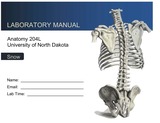
This laboratory manual is designed for undergraduate anatomy labs. It includes self-assessment resources and examination set up guides.
This edition has been superseded. The 2nd edition is available here: https://commons.und.edu/oers/8/
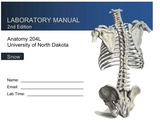
This laboratory manual is designed for undergraduate anatomy labs. It includes self-assessment resources and examination set up guides.

Short Description:
Note: This OpenStax book was imported into Pressbooks on July 22, 2019, to make it easier for instructors to edit, build upon, and remix the content. The OpenStax import process isn't perfect, so there may be formatting errors in the book that need attention. For information about how to get your own copy of this book to work on, see the Add Content part in the Pressbooks Guide. You can access the original version of this textbook here: Anatomy and Physiology: OpenStax.
Long Description:
Anatomy and Physiology is a dynamic textbook for the two-semester human anatomy and physiology course for life science and allied health majors. The book is organized by body system and covers standard scope and sequence requirements. Its lucid text, strategically constructed art, career features, and links to external learning tools address the critical teaching and learning challenges in the course. The web-based version of Anatomy and Physiology also features links to surgical videos, histology, and interactive diagrams.
Word Count: 146092
(Note: This resource's metadata has been created automatically as part of a bulk import process by reformatting and/or combining the information that the author initially provided. As a result, there may be errors in formatting.)

Students will learn about the basics of sexual and reproductive anatomy, as well as periods and menstrual care. This lesson is not intended to be divided by gender. We recommend all students learn together, as there is value in understanding all body types and functions, additionally this practice can help students de-stigmatize the natural variations in bodies and experiences.